There are two types of people who follow baseball: Yankee
fans and Yankee haters. While I'm in the latter camp on the best
team that money can buy, I'll have to admit to adoring Yankee
Stadium. It's such a beautiful park that my feelings toward the
team could easily mellow except that their greedy, fat-cat owner
George Steinbrenner intends to move the team to Manhattan or
New Jersey thus destroying the Yankees main redeeming quality.
As the first stop in my New England-Northeast Canada tour
back in 1992, I didn't want to put my new Eclipse at risk so
I parked in the team's parking deck. At $5 then, it was incredibly
cheap by comparison to other major league facilities. Unfortunately
the deck was so cramped and poorly laid out I feel fortunate
that no one dented my car while it was parked or in the nightmare
traffic afterwards. I've learned better since then. A natural
cheapskate, I'll park up to a mile away to avoid the outrageous
fees in, for example, Boston and Chicago, where I parked in the
Fens and Grant Park respectively. Walking is good exercise and
gives a better feel for the city.

Yankee Stadium is truly a city stadium. It's not a suburban
edifice rising high above surrounding parking lots. There is
no grand vista of her, no unobstructed view. Try as I might to
get an clear shot, there were always buildings or elevated roadways
in the way. Yankee Stadium is as integral to the neighborhood
as Fenway.
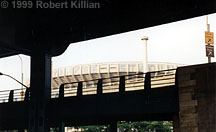 Depending
upon how you arrive (the stadium is convenient to both the subway
and I-87), you almost feel like Punxsutawney Phil, the groundhog.
Under a network of steel girders supporting the busy traffic
overhead, you peek out of your dark burrow, groggy from a winter's
hibernation, still unable to see your shadow because while you
may technically be above ground, you're still sheltered from
the sun. You gain only occasional glimpses at the Stadium before
suddenly you run into her. Depending
upon how you arrive (the stadium is convenient to both the subway
and I-87), you almost feel like Punxsutawney Phil, the groundhog.
Under a network of steel girders supporting the busy traffic
overhead, you peek out of your dark burrow, groggy from a winter's
hibernation, still unable to see your shadow because while you
may technically be above ground, you're still sheltered from
the sun. You gain only occasional glimpses at the Stadium before
suddenly you run into her.
Yankee Stadium is appropriately called The House That Ruth
Built. He was sold to the Yankees in 1919 and brought them pennants
in 1921 and 1922. Using the additional revenues generated by
Babe Ruth as a gate attraction, Yankee Stadium was completed
and opened in 1923. The Yankees promptly won the first of thirty-two
World Series. The stadium underwent major renovation in 1976
and smaller improvements in 1984 and 1987. The end result? The
interior views of the park are outstanding. Of course, I'm willing
to bet they were fantastic before.
Visual treats include an immaculately manicured field and
a backdrop of city buildings. The electronic scoreboard is only
average, and since it's a classic park, they might be better
served by going back to a manual. I will note that most ballparks
showcase on their electronic scoreboard a time-killer race between
innings that involve three different colored balls or horses
or penguins or whatever. Generally, I think these are stupid,
but the Yankees have a good one. Three different trains race
through the subway system, intercutting animation and live action.
Among the other renovations, the wedding-cake trim was moved
from the upper boxes to beyond the outfield fences. The field
is still not symmetrical, but the foul poles are still inviting
targets. It certainly is not as monstrously distorted as the
Green Monster in Fenway or the neotraditional pretension of the
Blue Monster in the Seattle Kingdome.
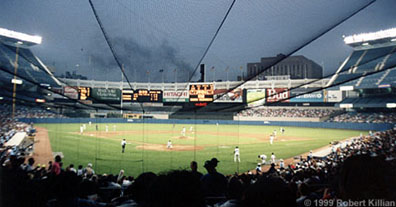
All the seats have good views without as many obstructions
as other older parks like Wrigley Field. The netting behind homeplate
mars the view a little worse than most. They also may have screwed
up the seat numbers big time. My ticket said F19, but instead
of being in the sixth row, mine was in the eighteenth -- it's
a scheme that defies description. Scalpers must have a field
day fooling buyers into thinking they are getting good seats.
In the bleachers or the boxes, no matter where I sat, the
fans were rabidly proYankee. They were playing the White Sox,
but nobody was wearing a White Sox cap. I've been to at least
a dozen Cardinal games at Veteran's Stadium in Philadelphia and
usually the Cardinal paraphernalia outnumbered that of the Phillies.
Here there were no enemy caps, not even the local New York Mets.
Queens might as well be in another country. Maybe some fans did
try to come in with enemy colors but they were mugged on the
way in. I enjoyed talking with these fans, who in my limited
experience were mostly Italians and a little obnoxious, but delightfully
colorful.
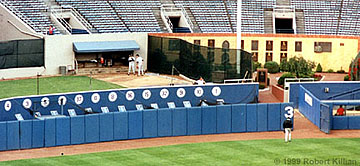 One
last note about the renovation. There are nineteen plaques commemorating
great Yankee players, managers, owners, and even the visits of
Popes Paul IV and John Paul II behind the centerfield wall in
the Yankee Stadium Monument Park. Prior to 1976 this area was
actually part of the playing field -- even the flagpole. Surely
opposing centerfielders were haunted, if not by the ghosts of
Yankee legends, then surely by the threat of running smack into
a flagpole. You can visit Monument Park, but get there early,
it closes 45 minutes before game time. One
last note about the renovation. There are nineteen plaques commemorating
great Yankee players, managers, owners, and even the visits of
Popes Paul IV and John Paul II behind the centerfield wall in
the Yankee Stadium Monument Park. Prior to 1976 this area was
actually part of the playing field -- even the flagpole. Surely
opposing centerfielders were haunted, if not by the ghosts of
Yankee legends, then surely by the threat of running smack into
a flagpole. You can visit Monument Park, but get there early,
it closes 45 minutes before game time.
Speaking of monuments, at some parks there are sculptures
of heroic baseball stars of the past: Stan Musial in front of
Busch Stadium, Honus Wagner in front of Three Rivers Stadium.
These men of stature are commemorated at stadiums built (in Wagner's
case a half century) after their careers were over. Hank Aaron's
statue used to adorn Fulton County Stadium, where in fact he
broke Babe Ruth's career homerun mark. Now it resides next door
at Turner Field. Perhaps I'm a curmudgeon, but this strikes me
a little like discovering a statue of General William "Tecumseh"
Sherman at the Richmond National Battlefield.
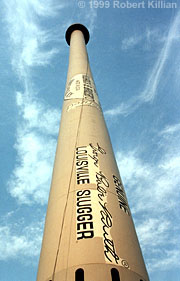 Yankee
Stadium, however, not only has a plaque in Monument Park for
Ruth where he spent the latter half of his career, but an eye-catcher
outside in the plaza. Instead of a slightly larger-than-life-size
bronze figure it's a representation of Ruth's bat even taller
than the Stadium. It would take a Paul Bunyanesque character
to swing that bat -- and that was Ruth. If they do tear down
Yankee Stadium, the bat should remain. This concept is not without
precedent. The homeplate of the original Comiskey Park may now
be in the middle of a parking lot, but it's still at it's original
location with a historical marker. Yankee
Stadium, however, not only has a plaque in Monument Park for
Ruth where he spent the latter half of his career, but an eye-catcher
outside in the plaza. Instead of a slightly larger-than-life-size
bronze figure it's a representation of Ruth's bat even taller
than the Stadium. It would take a Paul Bunyanesque character
to swing that bat -- and that was Ruth. If they do tear down
Yankee Stadium, the bat should remain. This concept is not without
precedent. The homeplate of the original Comiskey Park may now
be in the middle of a parking lot, but it's still at it's original
location with a historical marker.
There are plenty of great places to eat in New York, but eat
at the Stadium too. Deli sandwiches are available both at the
sidewalk cafe and in the park, but even their plain hot dogs
were incredibly plump and juicy. The fare in Yankee Stadium was
pretty standard otherwise. They don't have the range of sausages
available at Comiskey II, but their hot dogs are the best in
the majors, far outstripping the lame Dodger Dogs or Fenway Franks.
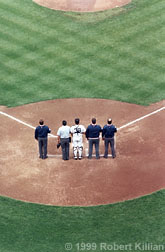 Yankee
souvenirs used to be pretty limited, until they started marketing
in a multitude of colors. Why is that cap in Tarheel Blue? Surprisingly
I don't mind the plethora of colors now available as much as
some of the sillier mascots adorning caps. But it's not really
needed. Basic black is enough when you start with the classiest
home uniforms in history. By the way, the Yankees did not switch
to pinstripes to make the Babe look slimmer. They first tried
pinstripes in 1912, before Ruth even broke into the majors with
Boston. They also weren't the first team to use pinstripes, but
after 1915 they became the permanent feature we all cherish (or
hate). Relying on Marc Okkonen's book, Baseball Uniforms in
the Twentieth Century, seven teams had tried pinstripes before
the Bronx Bombers nee Highlanders, three more came out at the
same time. Yankee
souvenirs used to be pretty limited, until they started marketing
in a multitude of colors. Why is that cap in Tarheel Blue? Surprisingly
I don't mind the plethora of colors now available as much as
some of the sillier mascots adorning caps. But it's not really
needed. Basic black is enough when you start with the classiest
home uniforms in history. By the way, the Yankees did not switch
to pinstripes to make the Babe look slimmer. They first tried
pinstripes in 1912, before Ruth even broke into the majors with
Boston. They also weren't the first team to use pinstripes, but
after 1915 they became the permanent feature we all cherish (or
hate). Relying on Marc Okkonen's book, Baseball Uniforms in
the Twentieth Century, seven teams had tried pinstripes before
the Bronx Bombers nee Highlanders, three more came out at the
same time.
I normally provide a list of local places to visit, but that
would be absurd for New York, where there are a million things
to do at a quarter 'til two in the morning. There are, for one
small example, a host of world-class museums, but I think the
Guggenheim is my personal favorite for its collection of early
20th-century Modernists.
Yankee Stadium and Tiger Stadium are my favorite classic parks.
Detroit is already scheduled to lose their gem, and New York
may lose theirs. So, if you can tolerate adding to Steinbrenner's
coffers, make sure to go see baseball at its best.
|
